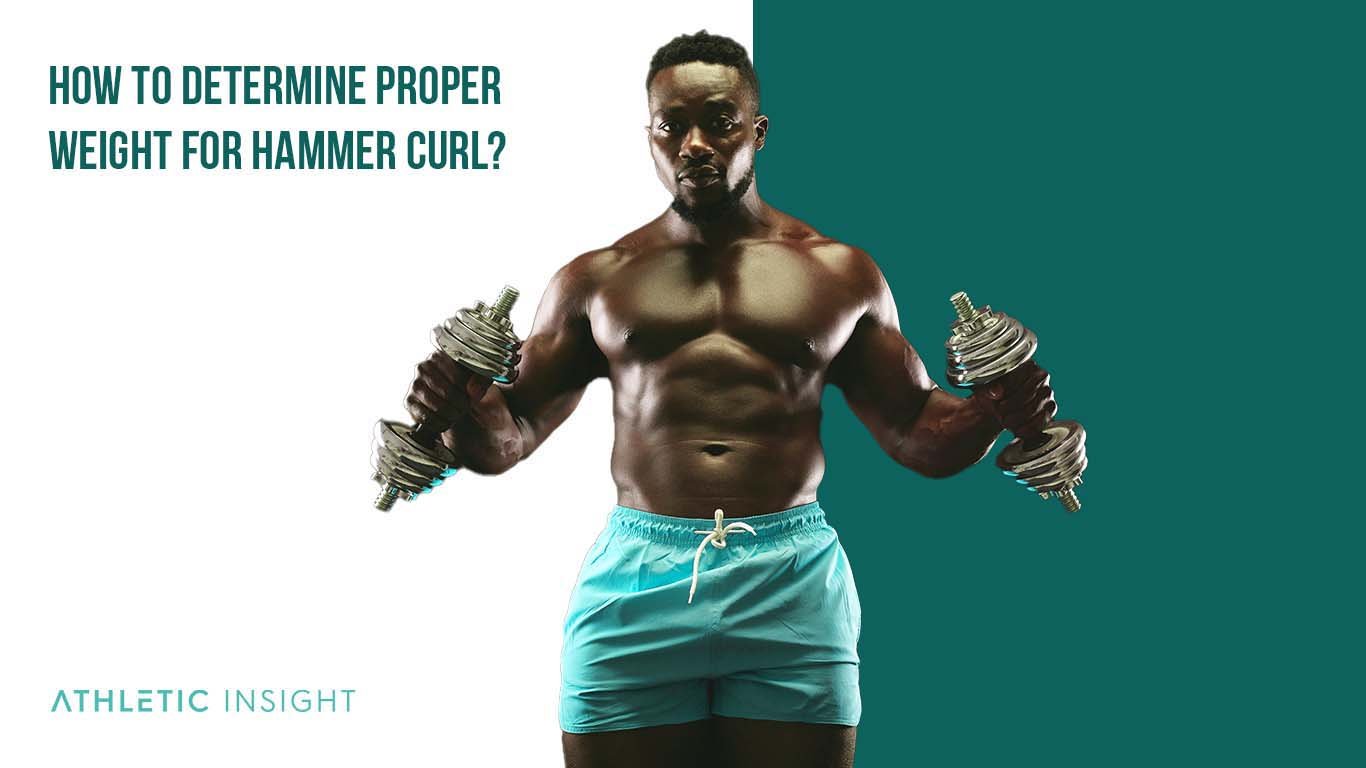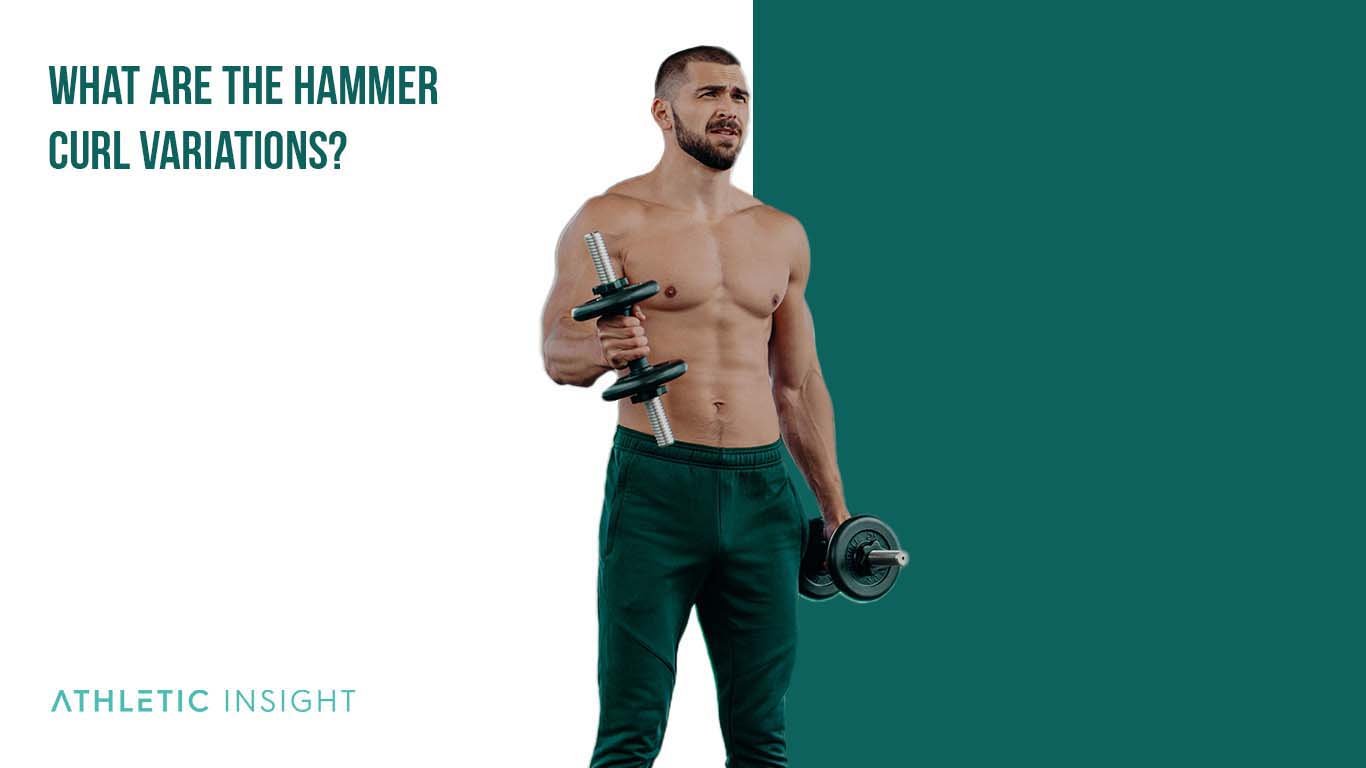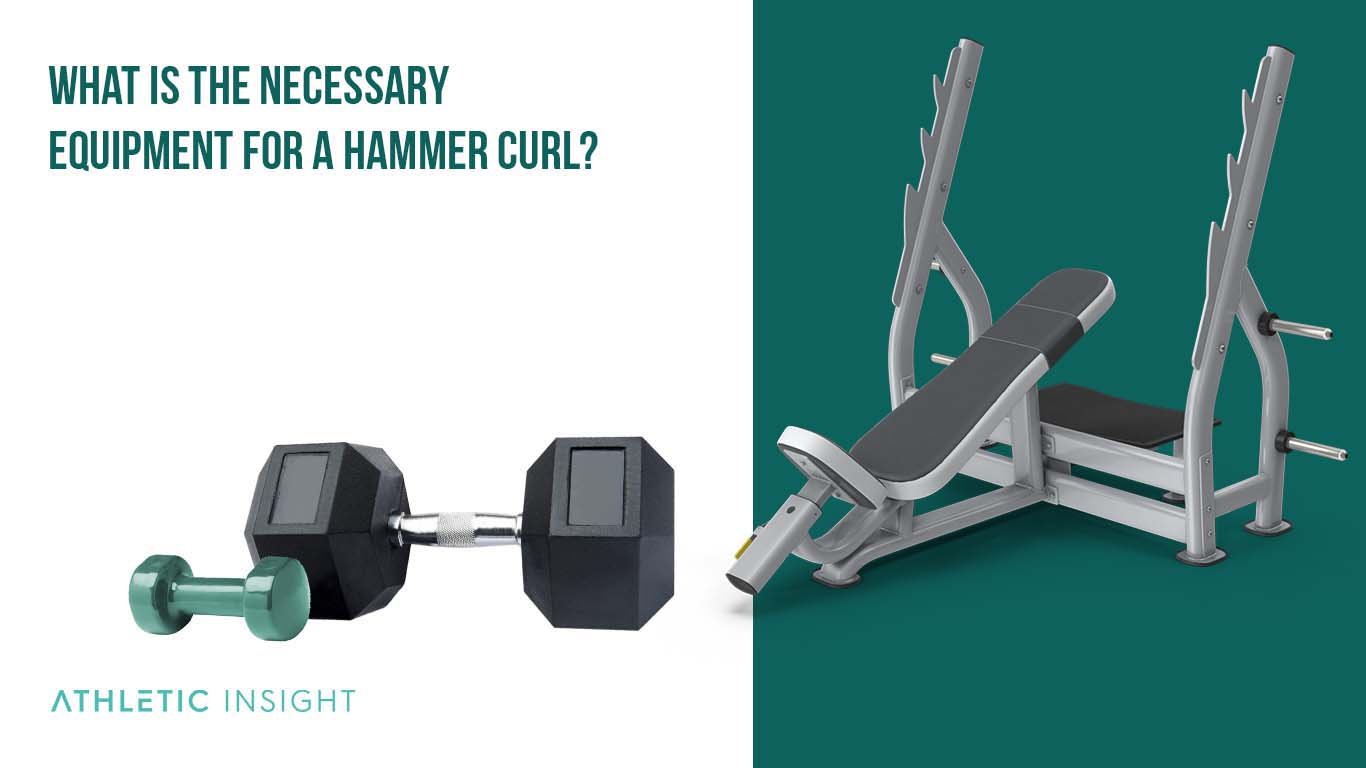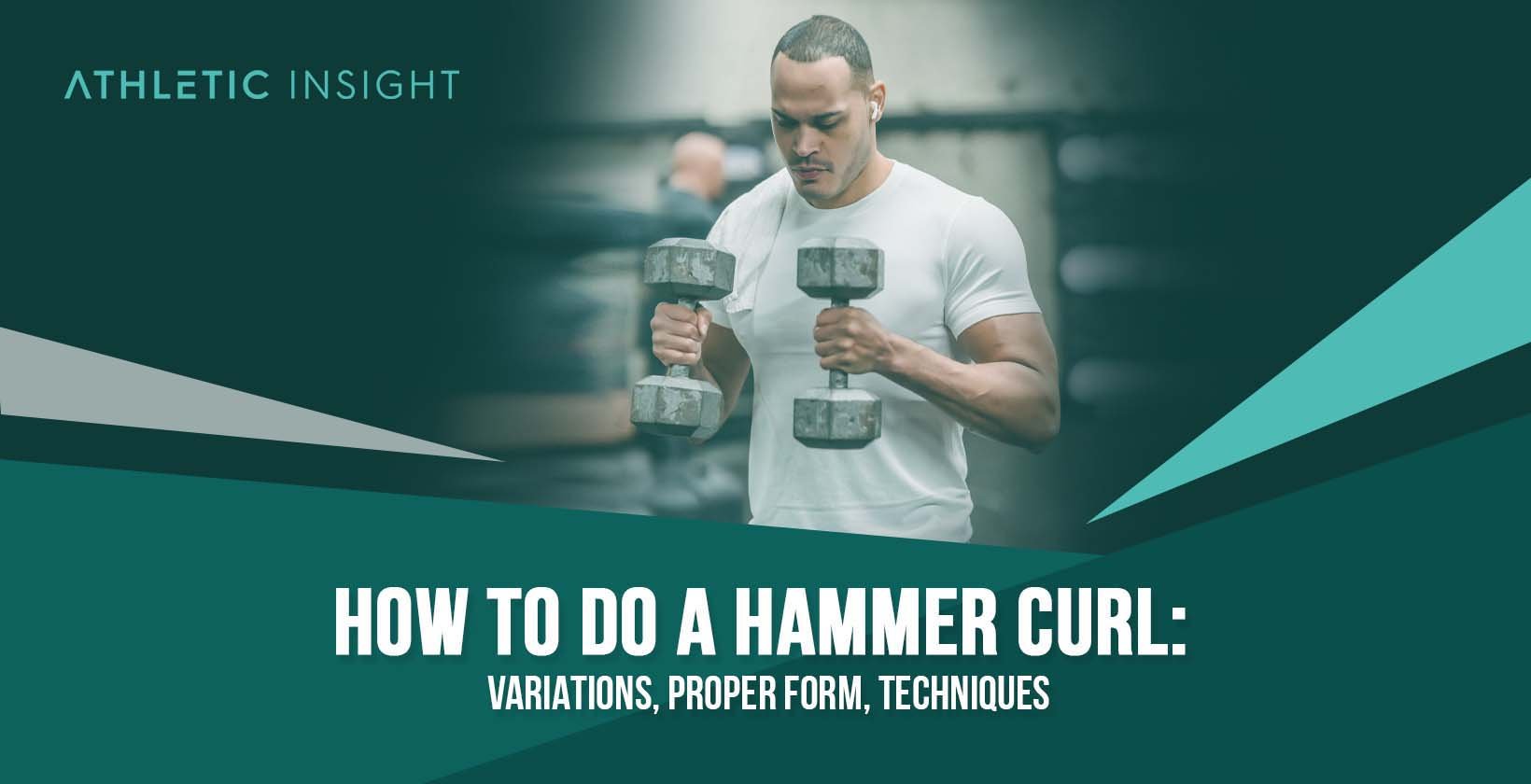The Hammer Curl is a strength training exercise that targets the biceps. You can perform this weight training exercise with two dumbbells and palms facing together in a curved downward motion.
The hammer curl works both the biceps brachii and the brachialis muscles, with emphasis on the former. The Hammer Curl is an isolation exercise that isolates the biceps. It involves one joint movement and benefits pulling performance, grip strength, and wrist and elbow stability.
Hammer Curls are sometimes known as Arched Hammer Curls to avoid ambiguity with dumbbell curls where both arms are supinated. It is named after its hammer-like motion which resembles that of using a hammer to drive nails into wood.
What is a Hammer Curl?
A hammer curl, a pivotal movement in your arm workout, diverges from the traditional bicep curl by its unique grip and the muscles it targets. When you perform hammer curls, your palms face each other, employing a neutral grip. This simple yet effective adjustment not only focuses on your biceps brachii but also engages the brachialis and brachioradialis muscles more intensely than standard bicep curls.
The range of motion in hammer curls is straightforward. Starting with your arms fully extended along your sides, you’ll curl the weights upwards, maintaining your palms’ inward facing position throughout the movement. The exercise can be executed using dumbbells, a cable machine with a rope attachment for cable hammer curls, or even a hammer curl barbell, offering versatility and options for progression.
For those exploring variations, crossbody hammer curls and inclined hammer curls add intensity and diversity, further challenging your muscles and promoting growth. Understanding how to do hammer curls effectively is crucial for maximizing the exercise’s benefits, including bolstered arm strength and enhanced muscle aesthetics. With consistent practice and proper form, incorporating hammer curls into your arm routine can significantly contribute to a more balanced and powerful upper body.
What Muscles Do Hammer Curls Work?
When you jump into hammer curls, you’re not just engaging your biceps. Hammer curls muscles worked include the brachialis and brachioradialis, critical muscles in the forearm. The unique grip of hammer curls, compared to standard bicep curls, targets these areas effectively.
The brachialis lies underneath the biceps and plays a pivotal role in flexing the elbow. Strengthening this muscle can significantly enhance your arm’s overall size and power. Meanwhile, the brachioradialis, located in the forearm, assists in flexion and grip strength. This makes daily tasks and other grip-intensive exercises easier.
You’ll also touch upon the bicep brachii, albeit differently than traditional curls. The hammer grip shifts the focus but still promotes hypertrophy in the biceps, contributing to a well-rounded arm development.
Including variations like incline hammer curls and crossbody hammer curl, further intensifies the engagement of these muscles, offering a comprehensive arm workout. Remember, incorporating a range of hammer curl exercises ensures balanced growth and strength improvement.
By understanding and practicing how to do hammer curls with proper form, you’re setting the stage for significant arm gains and functionality enhancement.
How to do a Hammer Curl?
1. Selecting the Right Weight
To start off, choosing the appropriate weight is crucial. It should be heavy enough to challenge your muscles but not so heavy that it compromises your form. If you’re new to hammer curls, experimenting with different weights can help you find your sweet spot.
2. Positioning Your Hands
When it comes to positioning your hands, the key lies in the grip. Hold the dumbbells with your palms facing each other, which is also known as a neutral grip. This position targets the hammer curls muscles worked efficiently, ensuring maximum engagement.
3. Executing the Curl
Keep your elbows pinned at your sides and exhale as you lift the dumbbells towards your shoulders. The movement should be smooth and controlled, focusing on the bicep and forearm muscles. Hammer curl variations like the crossbody hammer curl and incline hammer curls can add diversity to your workout.
4. Controlling the Movement
Control is pivotal. As you curl the weights up, make sure to do it in a controlled manner. Avoid swinging the weights or using momentum to lift. This ensures that hammer curls vs bicep curls target the intended muscles effectively.
5. Repeating the Exercise
Repetition is key to muscle growth. Aim for three sets of 8 to 12 reps, but listen to your body’s cues. If you feel like you can push for a few more hammer curls, go for it, but always prioritize form over quantity.
How to Perform Hammer Curl with Proper Form?
Proper form for this workout entails using an arc motion with palms facing inward toward each other. It’s called a Hammer Curl because your hands move in a hammer-like motion simultaneously when performing this strength training exercise. You can use the following steps to dominate the Hammer Curl.
- Straighten your legs without locking them.
- Align the knees beneath the hips.
- Place your arms at your sides with dumbbells against your outer thigh.
- Relax the shoulders and palms against the thighs, this pose is a good start.
- Bend the elbows, upper arms elevated, lower arms raised, upper arms raised.
- Place your palms facing inward, toward your body’s midline.
- Return to the starting position by lowering the weights.
Whether you are performing a bicep curl, a hammer curl, or even a preacher curl, it is important to change up your routine from day to day. Despite doing the biceps exercises, your muscle development will stall if you do not change your routine.
What are the Benefits of Hammer Curl?
When you’re looking into toning your arms, hammer curls are a superior choice. This exercise targets several key muscle groups, including the biceps brachii, brachialis, and brachioradialis. This comprehensive engagement leads to well-rounded arm development, distinguishing hammer curls from traditional bicep curls.
Incorporating hammer curls into your workout routine not only enhances muscle symmetry but also boosts your grip strength. This is crucial not just for lifting heavier weights but also for performing daily tasks with ease. With variations like the cross body hammer curl and incline hammer curls, you can further intensify muscle activation and add diversity to your workouts.
Also, hammer curls are versatile. Whether you opt for cable hammer curls, hammer rope curls, or standing hammer curls with a barbell or dumbbells, you’re guaranteed a rigorous arm workout. Plus, experimenting with hammer curl variations ensures your muscles don’t plateau, keeping your gains consistent.
- Develop bicep size and strength
- Improve wrist stability
- Develop muscle endurance
- Improve grip
- Boost forearm strength
- Increase bicep definition
What are the Risks of Hammer Curls?
While hammer curls can significantly enhance your arm muscle strength and aesthesis, overlooking the technique can lead to injuries. The most crucial aspect of hammer curls is maintaining proper form. Without it, you risk straining your brachialis or causing tendonitis in the elbow. This emphasizes the utmost importance of learning how to do hammer curls correctly.
If you’re advancing your workout with variations such as the cross body hammer curl or the incline hammer curls, recognizing the need to adjust weights is vital. Overloading too quickly without proper adaptation can onset muscle sprains. Besides, repetitive stress on the wrists during improper hammer curl barbell executions may instigate discomfort or injury.
Always be mindful of your body’s signals. If a particular movement like the hammer curl to press causes unease, reconsider your approach or consult a professional. Engaging in a variety of exercises, including hammer curl variations, spreads the workload across multiple joints and muscles, reducing the risk of overuse injuries.
Incorporate exercises targeting different aspects of arm and core strength, such as side plank variations and modified side plank, to ensure balanced muscle development and safeguard against the adverse effects of repetitive motions in your training regimen.
What are the Mistakes for Hammer Curl Form?
When you’re working on enhancing your arm muscles through hammer curls, avoiding common pitfalls is key to maximizing efficiency and reducing the risk of injury. One frequent error is not maintaining a neutral grip, which is essential for targeting the hammer curls muscles worked effectively. This grip ensures you’re engaging both the biceps and the brachialis properly.
Another mistake to watch out for is the elbow’s position. Some people tend to move their elbows forward or backward during the lift. For the best results, your elbows should stay by your sides, creating a stable base for the movement. This stability is crucial for isolating the muscles you’re aiming to build.
Incorrect weight choice can also hinder your progress. Picking weights that are too heavy might tempt you to use momentum to complete the curl, rather than relying on muscle strength. This undermines the exercise’s effectiveness and can lead to strain. On the flip side, weights that are too light might not provide enough challenge to stimulate muscle growth.
Also, the pace at which you perform hammer curls plays a significant role. Rushing through the exercises or using a jerky motion can prevent you from getting the full benefit of the workout and increase your injury risk. Slow, controlled movements ensure that you’re engaging your muscles thoroughly throughout the exercise.
Incorporating hammer curl variations such as cross body hammer curls, incline hammer curls, and seated hammer curls can help diversify your workout and target your muscles from different angles. Each variation brings its own set of challenges and benefits, keeping your muscles guessing and your workouts interesting.
Remember, understanding and rectifying these common mistakes in your hammer curl routine can lead to more efficient workouts and impressive muscle gains. Keep these tips in mind, and you’re well on your way to achieving your arm strength and aesthetics goals.
- Elbows in a resting position right below the shoulders, generally when curling your wrist moves even lower than this point. Avoid this at all costs.
- Moving the elbows closer to the body without moving them below the shoulder line is a Hammer Curl form mistake. It can lead to injury if not corrected carefully.
- Using the momentum of the weight and swinging it back without using your biceps can also slow down the development of the biceps muscles.
- Using a narrow grip makes you more susceptible to an elbow injury, so avoid it at all costs.
- Curling the weights too high like a preacher curl can cause back injury as well as bicep tendon damage.
- The Hammer Curl is a full range of motion exercise. That means you should be going from the starting position to the endpoint and vice versa in a full range of motion. Keeping your arms still at the top of the move is a mistake that will prevent biceps growth and can also trigger elbow injury
Remember, good hammer curl form intensifies bicep growth so it’s important to be consistent with the Hammer Curl exercises you do.
How to Determine Proper Weight for Hammer Curl?
The best method for picking the ideal weights for this exercise is to start with low weights and gradually increase them once you feel comfortable. Start with a manageable weight, nothing too light or too heavy, as you want to be able to feel some impact. You also want to avoid injuries like pulled muscles.

According to lifting standards, a healthy man should be able to average about 35 lbs on a hammer curl.
Which Muscles are Involved While Performing Hammer Curl?
The prime movers in the Hammer Curl are biceps brachii, brachialis, and brachioradialis. The biceps brachii consists of two heads — the long head and the short head. In the Hammer Curl, you work both heads of the biceps because you’re using a neutral grip.
The brachialis is beneath the biceps brachii, and it is the primary elbow flexor. The brachioradialis is on the outside of your forearm, and it too is an elbow flexor. The brachialis and brachioradialis assist with arm flexion when your grip is neutral, which will be in the Hammer Curl.
The forearms also do tremendous work during this exercise since you must use your wrist to curl the dumbbell.
The Hammer Curl works the entire arm. It specifically targets your biceps, brachialis, and brachioradialis. However, because of the positioning of your arms and wrists, you can’t avoid strengthening your forearms with this exercise.
What are the Hammer Curl Variations?
Hammer Curl variations increase the resistance to a Hammer Curl movement. Generally, you can change a Hammer Curl variation by changing a few techniques.

1. Seated Hammer Curl
In your journey to strengthen your arms, you’ll find seated hammer curls invaluable. This variation boosts stability, allowing you to focus intensively on the biceps and brachialis. Sit on a bench, keep your back straight, and curl the weights with palms facing each other. It’s perfect for beginners or those focusing on form.
2. Alternating Hammer Curl
Alternating hammer curls bring a dynamic touch. You’ll work one arm at a time, enhancing concentration and muscle engagement. This style not only works the hammer curls muscles but also improves coordination. Keep your elbows pinned to your sides and alternate arms smoothly for an effective session.
3. Cross Body Hammer Curl
Cross body hammer curls add a twist—literally. You’ll curl the weight across your body towards the opposite shoulder. This targeted variation works additional muscles like the forearm flexors, making it a superior choice for comprehensive arm development.
4. Incline Hammer Curl
Incline hammer curls are done by leaning on an incline bench. This position stretches the biceps more profoundly at the start, engendering a unique tension throughout the movement. It’s a fantastic way to challenge your muscles in a new way, fostering growth and strength.
5. Preacher Hammer Curl
At the preacher bench, preacher hammer curls isolate the biceps by minimizing the involvement of other muscles. This focused approach ensures that your biceps work harder with each curl. It’s an advanced variation that guarantees your efforts translate directly into muscle gains.
6. Hammer Curl Power Squat
Stand holding dumbbells at your side, then do a power squat (squat down with knees bent and hips back) while simultaneously curling the dumbbells. As you come up, do a shoulder press with the arms. Return to the starting position and repeat.
What are the Alternatives to a Hammer Curl?
1. Bicep Curl
The bicep curl is one fundamental exercise you can’t miss. It targets the same muscles as hammer curls but with a focus on the biceps brachii. You simply grip a barbell or dumbbells with palms facing up and curl towards your shoulders. This variation emphasizes the biceps more directly compared to the neutral grip of the hammer curl.
2. Concentration Curl
The concentration curl isolates the biceps muscles by ensuring that you’re focusing on unilateral movement. Sit on a bench, spread your legs, and rest your elbow on your thigh. The position prohibits body momentum, emphasizing bicep muscle work. It’s a great choice for sculpting peak bicep muscles.
3. Preacher Curl
Preacher curls use a preacher bench to isolate the biceps. You place your arms on the padded surface and curl a barbell or dumbbell. This position minimizes the involvement of other muscles, maximizing bicep engagement. Preacher curls are excellent for adding strict form and isolation to your arm workouts.
4. Cable Curl
Cable curls provide constant tension throughout the movement, unlike free weights. You’ll attach a handle to a low pulley cable machine and perform curls with palms facing upward. This exercise introduces a different resistance curve, making it an effective bicep builder and a solid alternative to traditional hammer curls.
5. Zottman Curl
The Zottman curl is a unique twist on standard curls. You combine the grips of hammer and traditional bicep curls in a single movement. Curl up with palms facing up, then rotate your hands to a hammer grip as you lower. This exercise works both the biceps and the forearm muscles, offering comprehensive arm development.
What is the Necessary Equipment for a Hammer Curl?
You will need the specific equipment listed below to perform a hammer curl.

- A set of dumbbells
- A preacher bench or an incline bench
- A Hammer Curl bar – if you want to try the hammer curl power squat
Who Named the Hammer Curl?
The name “Hammer Curls” comes from the hammer-like grip you have on the dumbbell when you do them. In the 1800s, strongman George Zottman developed the precursor to this exercise. Hammer curls became popular in the 50s when bodybuilders began using them.
Does Hammer Curl Affect the Hormones?
Yes, Hammer Curl can affect the hormones since it is an intense muscle workout. Intense muscle workouts can affect the hormones and increase muscle mass and strength.
Hormones such as testosterone and cortisol are released in the body during physical activity. Their levels vary based on the type of exercise, intensity, length of exercise, and other factors.
Is Hammer Curl Practiced Within CrossFit?
The chief characteristic of a CrossFit athlete is strength and endurance. They often train at very intense levels but don’t focus on bulging biceps and triceps. As a result, Crossfit athletes do not usually practice Hammer Curls.
Is Hammer Curl Dangerous?
Yes, Hammer Curls can be dangerous when you do them wrong. It is best to avoid excessive bouncing or jerking when you curl. If you do so, there’s a chance of injury. Going beyond the normal range of motion or having incorrect form increases your risk of injury.
Is Hammer Curl Push or Pull?
The Hammer Curl is a pull exercise. They can enhance pulling performance, grip strength, and wrist and elbow stability. When you push, your deltoid muscles contract and the biceps work as synergists. When you pull, the antagonistic function of the biceps gets reduced.
Is Hammer Curl a Compound Exercise?
No, Hammer Curl is not a compound exercise. A compound exercise works multiple muscle groups, such as the squat.
The main muscles involved in Hammer Curl are the biceps. It requires the use of only one joint. So it is an isolation exercise.
What Can replace Hammer Curl?
Yes, replace it with other exercises that focus on isolating and building the biceps. Below is a list of alternative exercises you can perform.
- Alternating Dumbbell Concentration Curl (one arm at a time)
- Dumbbell Alternate Hammer Curl
- Alternating Dumbbell Preacher Curl (one arm at a time)
- Preacher Curl
- Zottman Curl
- Neutral Grip Pull-Ups
Is the Hammer Curl Beginner-friendly?
Yes, Hammer Curl is beginner-friendly. Since it’s an isolation exercise, you can choose the appropriate weight for your strength level. Add more weight as you get comfortable or plateau.
How does the bicep curl differ from the hammer curl?
The bicep curl primarily targets the biceps brachii with a supinated grip, unlike the hammer curl that uses a neutral grip, engaging both the bicep and forearm muscles for a more holistic approach to arm strengthening.
Key Takeaways
- Hammer Curls Target Multiple Arm Muscles: Unlike traditional curls, hammer curls engage not only the biceps but also the brachialis and brachioradialis muscles, leading to a more comprehensive arm workout and enhanced muscle aesthetics.
- Proper Form is Essential for Maximizing Benefits: Maintaining a neutral grip and keeping elbows pinned to your sides throughout the movement are crucial for targeting the intended muscles and avoiding injuries.
- Variations of Hammer Curls Add Diversity and Intensity: Introducing variations such as cross body, incline, and seated hammer curls can further challenge your muscles, promote growth, and prevent workout monotony.
- Selecting the Right Weight and Repetitions is Key: Begin with a weight that challenges you without compromising form, aiming for three sets of 8 to 12 reps, adjusting as necessary for personal fitness levels.
- Common Mistakes Can Hinder Progress and Cause Injuries: Avoid common pitfalls such as using momentum to lift, incorrect weight selection, and not maintaining a neutral grip to ensure effectiveness and reduce the risk of strain.
- Incorporating Alternatives and Supplements Ensures Balanced Development: Alternating hammer curls with exercises like bicep curls, preacher curls, and Zottman curls helps achieve balanced muscle growth and reduces the risk of overuse injuries.



